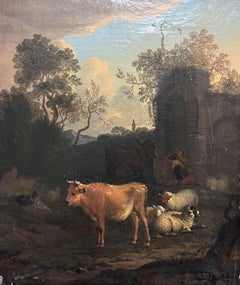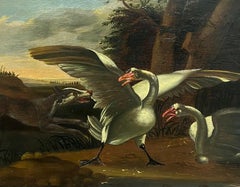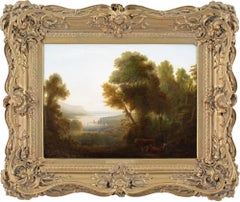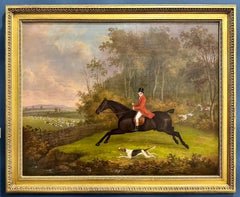1810s Animal Paintings
to
2
2
2
1
1
Overall Height
to
Overall Width
to
1
2
2
1
1
1
1
132
796
1,632
6,015
52
31
48
54
61
84
130
109
143
170
86
1
2
2
Period: 1810s
Village Scene Figures & Animals - British Old Master exh pastoral oil painting
By James Ward
Located in London, GB
This stunning British Old Master exhibited pastoral oil on panel is by noted artist James Ward. Painted circa 1815 with superb provenance, it was exhibited posthumously at the Royal ...
Category
Old Masters 1810s Animal Paintings
Materials
Oil
Rest of animals near a rustic fountain in the vicinity of a village
Located in Genève, GE
Work on canvas
Wooden frame and gilded plaster
71 x 83 x 7.5 cm
Category
Other Art Style 1810s Animal Paintings
Materials
Oil
Related Items
Fine 18th Century Dutch Old Master Oil Painting Cattle & Sheep Ancient Ruins
Located in Cirencester, Gloucestershire
Pastoral Landscape
Dutch Old Master, 18th century
oil on canvas, unframed
canvas: 12 x 10 inches
provenance: private collection, UK
condition: good a...
Category
Old Masters 1810s Animal Paintings
Materials
Oil
Antique Flemish 18th Century Oil Painting Swans Frightened by Dog in Landscape
Located in Cirencester, Gloucestershire
Swans Startled by Dog
Flemish Old Master, 18th century
oil on bevelled wood panel, framed
framed: 14.5 x 17 inches
panel: 10 x 13 inches
provenance: private collection, UK
condition:...
Category
Old Masters 1810s Animal Paintings
Materials
Oil
Fine 17th Century Dutch Old Master Oil Military Encampment Figures on Horseback
Located in Cirencester, Gloucestershire
The Military Encampment
Dutch School, 17th century
circle of Philips Wouwermans (Dutch 1619-1668)
oil painting on canvas, in 18th century gilt frame
canvas measures: 19.5 x 17 inches...
Category
Old Masters 1810s Animal Paintings
Materials
Canvas, Oil
H 27 in W 24 in D 2 in
19th Century Oil painting of horses - Mares and Foals in a Landscape
By Daniel Clowes
Located in London, GB
Daniel CLOWES (1774-1829) after George Stubbs
Mares and Foals in a Landscape
oil on canvas
29 x 33 inches, inc.frame
Daniel Clowes lived and worked in Chester all his life and ...
Category
Old Masters 1810s Animal Paintings
Materials
Oil
19th century Scottish Highland lock landscape with Highland Cattle drinking
Located in Woodbury, CT
Late 19th century Scottish Highland Lock landscape, with Cattle watering
E.Mulready was almost certainly a pseudo name for William Langley a well known English painter of landscapes...
Category
Victorian 1810s Animal Paintings
Materials
Oil, Canvas
Free Shipping
H 24 in W 32 in
French 19th century Chickens in a barn or chicken coop interior
Located in Woodbury, CT
French 19th century Chickens in a barn or Chicken coop interior
Charles-Emile Jacque (23 May 1813 – 7 May 1894) was a French painter of animals ...
Category
Victorian 1810s Animal Paintings
Materials
Oil, Wood Panel
Free Shipping
H 13 in W 18 in
c. 1800 Shepherd & Milk Maid with Cattle Pastoral Landscape Oil on Wood Panel
Located in Cirencester, Gloucestershire
Pastoral Landscape
by Peter la Cave (fl. 1789-1816)
oil painting on wood panel, framed
framed: 12.5 x 15 inches
panel: 8 x 10 inches
provenance: private ...
Category
Old Masters 1810s Animal Paintings
Materials
Oil, Wood Panel
17th century Flemish Old Master - Orpheus charming the animals with his music
Located in Antwerp, BE
17th century Flemish Old Master - Orpheus charming the animals with his music
The present painting is full of delightful details, such as the unicorn galloping in the distance, the pair of storks in the air, the shiny feathers of the peacock, ... .
In ancient Greek mythology, Orpheus was celebrated for his extraordinary musical talent and his ability to charm and enchant all living creatures with the melodies of his lyre. Legend has it that wherever Orpheus traveled, he was accompanied by a menagerie of animals drawn to the uplifting strains of his music.In lush forests and verdant meadows, Orpheus would sit beneath the shade of ancient trees, strumming his lyre and filling the air with melodies that stirred the hearts of all who heard them. Birds would perch on branches, their songs blending harmoniously with Orpheus's own, while deer and rabbits emerged from their hiding places to listen, their eyes shining with wonder and delight.Even the fiercest of beasts, such as lions and wolves, would approach Orpheus with caution, only to be soothed by the gentle rhythms of his music. They would lie down beside him, their wild instincts tempered by the tranquility of the melodies, creating scenes of rare harmony and peace in the natural world.Orpheus's ability to connect with animals through his music was a testament to the universal power of art and creativity. His story serves as a reminder of the profound bond that exists between humans and the natural world, and the transformative impact that music and beauty can have on our lives.
Jacob Bouttas, born in Antwerp, Belgium, in 1660, hailed from a family of artists with a rich artistic tradition. Like his father and teacher Frederic Bouttats II and his grandfather Frederic Bouttats I, he was strongly influenced by Jan Bruegel the Elder and the Brueghel-spirit echoes through his oeuvre. He specialized in painting landscapes with biblical and mythological scenes populated by small figures and animals (visible in, amongst other collections, Munich, Alte Pinakothek; Dijon, Musée des Beaux-Arts). A series of twelve coppers dedicated to the creation of the world according to the Genesis story, from the separation of light and darkness to the descent of Adam is preserved in the Museum of Navarra.
Provenance:
Private collection France
Measurements:
75 * 95 cms. Framing options available.
Antwerp hands panelmark visible verso, indicating a date of creation of the panel in the first half of the 17th century, after 1620. Panels were expensive at the time, especially this size and approved by the Antwerp panelmalers guild. A similar composition (measuring ca. 73 * 105cms) was offered at a leading auction house in Vienna in 2003 as attributed to Jacob de Backer...
Category
Old Masters 1810s Animal Paintings
Materials
Oil, Panel
18th Century sporting horse portrait oil painting of a race horse and groom
Located in Nr Broadway, Worcestershire
Francis Sartorius
British, (1734-1804)
Bay Hunter & Groom
Oil on canvas, signed
Image size: 24.25 inches x 29.25 inches
Size including frame: 32 inches x 37 inches
A wonderful spor...
Category
Old Masters 1810s Animal Paintings
Materials
Oil, Canvas
Oil Painting 19th Century Cows Landscape Barbizon
By Antonio Cortes
Located in Saint-Ouen, FR
CORTES Antonio (1827-1908)
Cows to pasture
Oil on canvas signed lower left
Old frame gilded with leaves
Dim canvas : 54 X 65 cm
Dim frame: 70 x 86 cm...
Category
Barbizon School 1810s Animal Paintings
Materials
Oil
H 27.56 in W 33.86 in D 2.37 in
Shepherd with Sheep, Cows and a Goat in a Landscape by Jan Frans Soolmaker
Located in Stockholm, SE
This painting depicts a pastoral scene that is attributed to the artist Jan Frans Soolmaker, an artist known for his Italianate landscapes and scenes that often feature equestrian and Arcadian elements. The painting is not signed but is attributed to Soolmaker, relating it to a known signed work by the artist that was sold at Sotheby’s London in 1999.
The scene is suffused with the warm glow of a setting or rising sun, casting a soft light that is characteristic of Soolmaker’s landscapes. It shows a shepherd guiding a group of cattle across a shallow stream, with the animals taking center stage in the composition. The animals are rendered with careful attention to their forms and the play of light on their bodies, which is a hallmark of Soolmaker's work. The landscape is composed of a rocky terrain with trees and shrubbery, creating a sense of depth and natural beauty that invites the viewer to explore the scene further.
The background suggests a vast, open landscape with distant mountains, which adds to the Italianate feel of the painting. The sky is dramatic, with clouds catching the light of the sun, contributing to the overall serene yet dynamic atmosphere of the work.
The provenance of the painting is notable, having been in the possession of significant historical figures such as Swedish Prince Fredrik Adolf, and later The collection of Pär Ulmgren, The collection of Gösta Stenman, and Engineer and politician Gustaf Henry Hansson.
Potential buyers have the option of choosing between a newly made gold frame or an older brown frame, which allows for personalization in how the work is presented.
Soolmaker’s work is often compared to that of Dutch painter Nicolaes Berchem, whose style he emulated. Soolmaker's landscapes reflect a similar sensitivity to light and composition, making his works sought after for their beauty and historical significance. Despite the smaller body of work left by Soolmaker, due to his short career, his paintings are valued for their craftsmanship and the legacy of the artist’s brief but impactful contribution to the Dutch Italianate landscape genre.
Information:
Jan Frans Soolmaker (Flanders 1635‑1685)
Shepherd with Sheep...
Category
Old Masters 1810s Animal Paintings
Materials
Oil, Canvas
H 22.05 in W 20.87 in
George paice, 19th century, oil, horse and rider with dogs
By George Paice
Located in York, GB
A fine oil on canvas painting of a horse and rider with hounds.
This traditional country scene shows the rider wearing his red hunting jacket, identified as Mr Mackenzie riding "dut...
Category
Old Masters 1810s Animal Paintings
Materials
Oil
Free Shipping
H 25.2 in W 31.5 in
Previously Available Items
Early 19th-Century British School, Romantic Landscape With Cattle & Coastal View
Located in Cheltenham, GB
This picturesque early 19th-century British oil painting depicts a romantic landscape with sailboats, cattle, estuary, and coastal view. It’s a celebration of nature delivered in air...
Category
Romantic 1810s Animal Paintings
Materials
Oil, Canvas
Antique English 19th century, Fox huntsman and hounds in a landscape.
By James Barenger
Located in Woodbury, CT
Barenger was born in Kentish Town, London, the son of James Barenger Snr., a metal chaser and artist who exhibited paintings of insects at the Society of Artists and Royal Academy, and Sarah Woollett, the daughter of the engraver, William Woollett. His brother Samuel Barenger (christened Major Samuel Barenger) also became an engraver. Beginning as a landscape artist, Barenger went on to specialise in painting horses, dogs and other animals, and hunting scenes. In 1807, at the age of 28, he exhibited at the Royal Academy for the first time. At this stage, he was living with his father in Kentish Town, but later moved to Camden Town. He went on to exhibit 48 paintings at the Royal Academy and eight at the British Institution. He acquired numerous wealthy and aristocratic patrons, and his pictures were also engraved for sporting publications such as W. H. Scott's British Field Sports...
Category
Victorian 1810s Animal Paintings
Materials
Oil, Canvas
Free Shipping
H 32 in W 37 in
I Moore, Provincial Early 19th-Century English School, Bay Horse & Groom
Located in Cheltenham, GB
This early 19th-century oil painting by British artist I Moore depicts a horse with its dapper groom.
With his left hand clutching the reins, a smartly-attired young groom stands proudly alongside a bay mare. He’s dressed in a style befitting the 1810s with boots, pantaloons, coat and cravat. His top hat carries an intriguing black rosette, perhaps relating to an award.
It’s likely that the painting was commissioned by the owner of a fine British country house who instructed a local artist. They’ve worked in a manner associated with well-known 18th-century equine painters such as George Stubbs, John Wootton and John Nost Sartorius. Only one other work by I Moore can be found, which dates to circa 1780...
Category
Folk Art 1810s Animal Paintings
Materials
Oil, Board, Canvas
Bernard-Ed. Swebach (1800-1870) - Squire training the horse of King Louis XVIII
Located in BELEYMAS, FR
Bernard-Edouard SWEBACH
(Paris 1800 – Versailles 1870)
Squire training the horse of King Louis XVIII
Oil on canvas
H. 24.5 cm; L. 33 cm
Signed and dated lower left, 1819
Origin :
– Office of Mr. de Villers
– Sale of June 19, 1992, Drouot, Couturier-de Nicolaÿ study, catalog No. 68 – Price excluding fees: 225,000 Francs, the equivalent of €34,300 excluding fees
– Mark Brady Gallery, New York
– American private collection
Sometimes reduced to a simple imitator of his father Jacques-François Swebach-Desfontaines (1769-1823), Bernard-Edouard demonstrates an astonishing artistic maturity in this true little masterpiece produced at only 19 years old.
Even if his name has remained quite famous among lovers of old painting, few biographical elements are known to us. Le Bénézit specifies that Bernard-Edouard entered the Beaux-Arts in Paris on February 28, 1814, but without indicating in the studio of which master; his true mentor remaining his father, both from a technical point of view and for the inspiration of the subjects treated: horses, hunting scenes, stables... When in 1815 the father was called by Tsar Alexander 1st to direct the manufacture of St. Petersburg porcelain, the son accompanies him; however, this Russian stay, which lasted until 1820, was interrupted by frequent returns to Paris, as evidenced by our painting dated 1819 and executed in France, and another (representing a battle of oriental horsemen) from the same year. Note that these two paintings are signed "Ed. Swebach", thus avoiding any confusion with the father and a sign of an already asserted artistic personality, while later works will simply be signed "Swebach", i.e. to indicate a two-handed realization. , or to maintain some ambiguity as to the author.
Bernard-Edouard, while in Russia he had already enjoyed an excellent reputation since 1820, made himself known to the French public on the occasion of his first participation in the Salon in 1822; he will exhibit there, irregularly, several paintings until 1838.
He also had a fairly important activity as an engraver and lithographer: for example the Disagreements of the hunt with hounds, a series of 12 plates published in Brussels in 1840, La Chasse au cerf, another series of 12 plates, a series on the Revolution of July 1830...
Swebach owned a country residence in Aulnay where he regularly received friends. He ended his life in Versailles, dying at n° 84, rue Royale, in the presence of his wife Jeanne-Julie d'Astier, whom he had married in 1850.
As we have mentioned, art historians or critics of the time (such as Augustin Jal) did not fail to underline the stylistic proximity to his father; yet Bernard-Edouard represents rather a mix between Carle Vernet and the English equestrian painters of the time, while his father is more a synthesis between a 17th century Dutch side (Wouwermans, Berchem…) and contemporary artists like Demarne or Taunay.
In our painting there is even a romantic and somewhat fiery side that we find in works of the same period by Géricault or Horace Vernet, and which will not necessarily be present in his later creations.
Our painting illustrates the young Swebach's closeness to royal power; this will be confirmed for example by the painting of the Salon of 1824, which represents a horse race where the royal prize is awarded by Louis XVIII.
The subject is therefore that of a squire from the Maison du Roi mastering Louis XVIII's own horse, as indicated by the handwritten inscription on the frame, the scene probably taking place in Versailles, in view of the landscape, and not in the Parisian stables of the King, place du Carrousel.
The school of Versailles, made up of the Grande and the Petite Écurie, had closed in 1810 and was reopened in 1814 by the Grand Ecuyer of France, the Vicomte d'Abzac (1744-1827). Beyond the teaching of riding to the military nobility, the Stables housed the King's war and hunting horses, which were trained and ridden there.
The squire represented here is very probably the young Antoine Cartier, Viscount of Aure (1799, Toulouse – 1863, Saint-Cloud). A former student of the Prytanée de La Flèche, then a graduate of the military school of Saint-Cyr in 1815, Aure joined the King's bodyguards in Versailles in 1816, then followed an instruction course at the Grande Écurie. He was named student squire by d'Abzac in 1817. At the time of our painting, he was already Louis XVIII's cavalcadour squire, i.e. he had command (choice, training, exercise) of the stable of horses serving in the person of the King. Close to Louis XVIII, who appreciated his social ease and his salient mind, Aure gave riding lessons, among others, to Charles X, the Duke of Angoulême and the Duchess of Berry, then to the sons of Louis-Philippe.
When the school of Versailles was finally closed in 1830, AurHe held positions of responsibility at the cavalry school in Saumur, at the Haras du Pin, and ended his career under Napoleon III as director of the Emperor's stables, then as Inspector General of the stud farms in 1861.
The trainer in our painting may correspond to the physical description of Aure given by André Montheilet: "... tall, well made, elegantly built, expressive face, mobile, almond-shaped eyes, charming a tad mocking lips very delicate, nose a bit strong…”. The confrontation between the man and the irritable stallion does not prevent the squire from displaying his mastery of the situation, a mixture of authority and tact towards the animal.
As for King Louis XVIII, it is not certain that in 1819 he could still ride on horseback because of his very overweight and poor health; he had however succeeded in 1818 in organizing a court hunt (the only one of his reign) in the forest of Rambouillet. It is even said that from 1815, from his Parisian palace in the Tuileries, he no longer traveled beyond Saint-Cloud.
We may have a doubt about the identity of the first owner of this painting, mentioned on the back of the canvas as belonging to the "Cabinet of M. de Villers".
The first hypothesis, the most attractive and altogether quite coherent, would go to the collection of the architect Michel Jean Maximilien Villers born in Saint-Martin du Parc in the Eure, a pupil of Percier, who married in 1794 Marie-Denise Lemoine (1774-1821), female painter like her sister Marie-Victoire and her cousin Elisabeth Gabiou (future Chaudet). The element of doubt concerns the absence of a particle in all the written sources concerning him.
However, Maximilien Villers was a well-known collector, whose dealer Lebrun organized a sale in 1812: alongside works by old masters, there were paintings by Gauffier, Bidauld, Thibault, Carle Vernet, Demarne, and his wife. .
Moreover, Villers was close to royalist circles. He thus worked for the Duchess of Angoulême: restoration of the gardens of the castle of Villeneuve-l'Etang in Marnes la Coquette...
Category
French School 1810s Animal Paintings
Materials
Oil, Canvas
Free Shipping
H 9.65 in W 13 in
Early 19th century portrait of a cavalier dressed man on a horse in a landscape
Located in Woodbury, CT
Early 19th-century portrait of a Cavalier dressed man on a horse in a landscape.
Well painted study of a horseman seated on his horse, dressed in a Cavalier outfit.
Oils on a panel...
Category
Old Masters 1810s Animal Paintings
Materials
Wood Panel, Oil
Free Shipping
H 14 in W 12 in
Set of 4 early 19th century Fox hunting landscape with men in red upon horseback
Located in Woodbury, CT
Set of 4 early 19th century Fox hunting landscape with men in red upon horseback.
John Nost Sartorius (1755-1828) was an English painter of horses, horse racing, and hunting scenes....
Category
Victorian 1810s Animal Paintings
Materials
Oil
Free Shipping
H 7.5 in W 9.5 in
Recently Viewed
View AllMore Ways To Browse
Abraham Lincoln Sculpture
Horse And Jockey Painting
Hound Paintings
Oil Of Pig
Portrait Hound
Red Bunny
Switzerland Alps Framed
Terrier Dog Antique
Victorian Dog Paintings In Oil
Dog Horse Fine Art
Oil Painting Of Parrots
Big Cat Painting
Derby Animals
19th C Horse Painting
Crab Painting
Dogs Victorian Painting
English Hunt Paintings
Oil Painting Of Monkey





